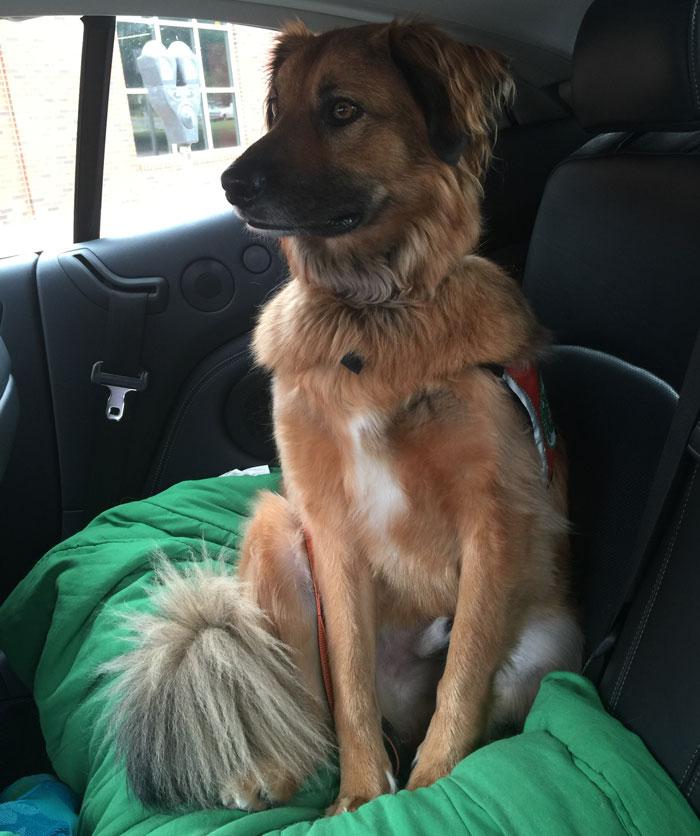
Pet Obesity
Wednesday, October 5, 2016
An estimated 58 percent of cats and 54 percent of dogs in the United States are overweight or obese according to the Association of Pet Obesity Prevention.
Weight loss is tough for anyone—two-or four-legged. However, losing weight and getting in shape can add years to your pet’s life and can increase the quality of those years.
As few as five pounds for dogs and two pounds for cats above their normal weight can put your pet at risk for developing serious medical conditions.
Numerous studies have linked type 2 diabetes, respiratory and heart disease, high blood pressure, and many forms of cancer to pet obesity. Obese pets are at an increased risk of knee injury. If your pet has arthritis, it is made worse by being overweight. Pets with heart or respiratory disease suffer more when they are overweight. In our hot weather obesity increases the risk for heat stroke.
Overweight or obese pets are expected to live shorter lives than their fitter counterparts. Also, heavier pets tend to be less energetic and playful, limiting the interaction they have with their families.
Consult your veterinarian before placing your cat or dog on a diet.
Cats’ physiology differs from humans and dogs. Cats can develop a life-threatening form of liver disease, hepatic lipidosis, if not fed properly.
A dog’s excess weight gain could be caused by an underlying disease. Have your veterinarian examine your pet prior to beginning a diet program to rule out problems other than over eating.
Your veterinarian can determine the ideal weight for your pet (cat or dog) and then determine the number of calories your pet should consume on a daily basis.
Counting calories is important in a weight loss program. Feeding too much will result in no weight loss. Not feeding enough can cause serious consequences in both cats and dogs such as hepatic lipidosis.
If your veterinarian suggests a diet change to help your pet lose weight, introduce the new food over a two-week period. Start by substituting one-quarter of the new food for two to three days. Then increase the volume to one-half new food for another two to four days. Then increase the amount to three-quarters for a couple days before switching to 100 percent of the new diet.
If the diet food does not appeal to your pet, try warming the food, or adding oregano or a splash of omega-3 fatty acid supplement. You can also try adding salmon juice over the food with your veterinarian’s approval.
Remember that pet treats can be a significant source of calories in your pet’s diet. Consider those snacks as a source of empty calories. Try offering green beans, apples, carrots or melon pieces as a treat instead.
As with any weight loss program, exercise plays a key role. While you decrease the number of calories consumed, you need to increase the number of calories burned.
Walking is an excellent activity for both owners and pets. Some dogs like to swim –another great form of exercise for those pets with arthritis that do not like to walk.
Move your pet’s food bowl to various locations to make them walk to find it. Switch it from upstairs to downstairs and vice versa. Or place small amounts of food in multiple locations for your pet to find.
Relocate the food bowl far away from your pet’s favorite haunts.
Try new toys to excite and engage your pet.
Cats like feather toys, flashlights, paper bags, or balls to chase. Dogs enjoy squeaky toys, balls, and laser pointers. Experiment and rotate the toys so they don’t become boring to your pet.
Try to engage your pet for at least 10 to 15 minutes twice a day.
If you have multiple pets and not all are overweight, feed them separately. Do not leave food out when you’re away as you won’t know who ate what. For cats, feed the normal cat up high where the heavier cat can’t go.
For the reluctant pets, here are some tips:
- Do not use a self-feeder; it’s like an unlimited candy machine. If you must, dispense a set amount of food several times per day.
- When your pet begs for food, pet your cat or dog or play with it. Walk your dog when it begs for food.
- Feed small meals frequently. Divide the total volume or calories into smaller meals. Give your pet one of these right before bedtime to avoid being woken in the night by a begging pet.
- When the bowl is empty, offer fresh water in their water bowl.
Remember to weigh-in and see your veterinarian for rechecks to make sure your pet is healthy during its weight loss program.
by Elisabeth J. Giedt, DVM

The above photos are of Charlie, a Pete's Pet Posse therapy. The left image is Charlie prior to implementing a strict diet and exerice plan and the right is Charlie after.
Veterinary Viewpoints is provided by the faculty of the OSU Veterinary Medical Hospital. Certified by the American Animal Hospital Association, the hospital is open to the public providing routine and specialized care for all species and 24-hour emergency care, 365 days a year.

